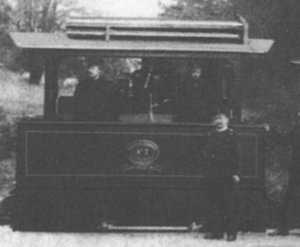- Mecklenburg XVIII
-
Mecklenburg XVIII Number(s): D.H.E. 1 and 2
M.F.F.E 1001 and 1002Quantity: 2 Manufacturer: Hohenzollern AG Düsseldorf-Grafenberg Year(s) of manufacture: 1886 + 1887 Retired: 1916 Wheel arrangement: 0-4-0 Axle arrangement: B n2t Gauge: 900 mm (2 ft 11 1⁄2 in) Length over couplers: 4,000 mm (13 ft 1 in) Height: 2,950 mm (9 ft 8 in) Overall wheelbase: 1,250 mm (4 ft 1 in) Empty weight: 7.50 t / 8.50 t Service weight: 8.50 t / 9.50 t Adhesive weight: 8.50 t / 9.50 t Axle load: 4.25 t / 4.75 t Top speed: 35 km/h (22 mph), later 31 km/h (19 mph) Coupled wheel diameter: 800 mm (31 in) Valve gear: Joy Cylinder bore: 200 mm (7.9 in) / 220 mm (8.7 in) Piston stroke: 350 mm (14 in) Boiler Overpressure: 12 bar No. of heating tubes: 78 / 37 Heating tube length: 1,350 mm (4 ft 5 in) Grate area: 0.36 m2 (3.9 sq ft) Radiative heating area: 2.15 m2 (23.1 sq ft) Tube heating area: 11.25 m2 (121.1 sq ft) / 13.28 m2 (142.9 sq ft) Evaporative heating area: 13.40 m2 (144.2 sq ft) / 15.43 m2 (166.1 sq ft) Water capacity: 0.75 m3 (160 imp gal) / 0.69 m3 (150 imp gal) Fuel: 0.16 t Locomotive brakes: Hand brake Train brakes: Heberlein The Grand Duchy of Mecklenburg Friedrich-Franz Railway (Großherzoglich Mecklenburgische Friedrich-Franz-Eisenbahn) grouped two, narrow gauge, steam locomotives taken over from the Doberan-Heiligendamm railway (Doberan-Heiligendammer Eisenbahn or DHE) into the Mecklenburg XVIII engine class.
Contents
History
For the opening of the 6.6 km (4.1 mi) long railway line from Doberan to Heiligendamm the DHE had procured two 'tramway' locomotives, which were given the numbers 1 and 2. The long section through the town in Doberan in particular made the procurement of such engines sensible. When the private railways were nationalised in 1890 the locomotives were renumbered to 1001 and 1002. Not long afterwards, it became clear that the locomotives were not able to cope with the rising levels of traffic as they could only haul a three-coach train. So in 1891 and 1898 Class XIX engines were procured. The tramway locos were retired in 1916.
Design Details
The locomotives were designed as box frame engines (Kastenlokomotiven) and had an outside plate frame with a well tank. The two saturated steam engines were on the inside, and the diagonally-oriented cylinders drove the rear coupled axle. The entire running gear was covered. Suspension was provided by leaf springs over the axle boxes. The boiler was horizontal. The firehole was located on the right hand side. In order to keep the minimise the impact when driving through Doberan, exhaust steam was expelled through a condenser. The footplate was located on the right hand side and could be used for driving both forwards and backwards due to the good visibility it afforded. Reversing the Joy valve gear was achieved using a lever working a crossed eccentric rod.
Literature
- Hans-Joachim Kirsche, Hermann Lohr, Georg Thielmann: Lokomotiv-Archiv Mecklenburg/Oldenburg transpress, Berlin 1989, ISBN 3-344-00326-7
See also
External links
- There is a relevant English-language forum at Railways of Germany
Classes of Mecklenburg locomotive Early locomotives 
Passenger train locomotives Mecklenburg III · Mecklenburg IV · Mecklenburg P 2 · Mecklenburg P 3.1 · Mecklenburg P 3 · Mecklenburg P 4.1 · Mecklenburg P 4.2 · Mecklenburg P 8Goods train locomotives Mecklenburg G 2 · Mecklenburg G 3 · Mecklenburg G 4.2 · Mecklenburg G 5.2 · Mecklenburg G 5.4 · Mecklenburg G 7.2 · Mecklenburg G 7.3 · Mecklenburg G 8.1Tank locomotives Mecklenburg XI · Mecklenburg XII · Mecklenburg XIII · Mecklenburg XIIV · Mecklenburg T 3a · Mecklenburg T 3b · Mecklenburg T 4 · Mecklenburg T 9.2 · Mecklenburg T 9.3Narrow gauge locomotives Categories:- 0-4-0T locomotives
- Grand Duchy of Mecklenburg Friedrich-Franz Railway locomotives
- 900 mm gauge locomotives
Wikimedia Foundation. 2010.

